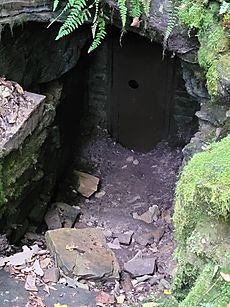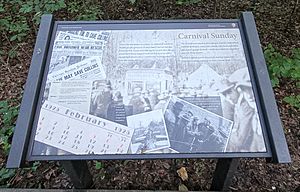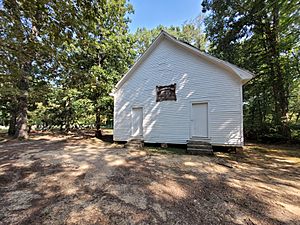Floyd Collins facts for kids
Quick facts for kids
Floyd Collins
|
|
|---|---|
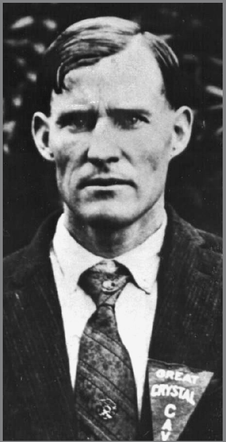
Collins in Cave City circa 1924
|
|
| Born |
William Floyd Collins
July 20, 1887 Auburn, Kentucky, U.S.
|
| Died | c. February 13, 1925 (aged 37) Cave City, Kentucky, U.S.
|
| Resting place | Mammoth Cave Baptist Church Cemetery, Mammoth Cave, Kentucky |
| Known for | Cave exploration in Central Kentucky; being trapped in Sand Cave and dying before a rescue party could get to him |
William Floyd Collins (born July 20, 1887 – died February 13, 1925) was an American cave explorer. He explored many caves in Kentucky, a state known for its huge cave systems. Today, many of these caves are part of Mammoth Cave National Park, which has the longest known cave system in the world.
In the early 1900s, there was a time called the "Kentucky Cave Wars." During this time, cave explorers and landowners competed fiercely. They wanted to find and open caves to make money from tourists. In 1917, Floyd Collins found Great Crystal Cave. He tried to make it a tourist attraction, but it was far away, so not many people visited. Floyd wanted to find a new cave closer to main roads. He made a deal with a neighbor to explore and open a small cave called Sand Cave.
On January 30, 1925, while making Sand Cave bigger, Collins got stuck. He was in a very tight passage about 55 feet (17 m) underground. The effort to rescue him became a huge national news story. It was one of the first big events reported using the new technology of broadcast radio. After four days, rescuers could give Floyd food and water. But then, rocks fell in the cave, blocking the entrance. Floyd was trapped inside for more than two weeks. Rescuers could only talk to him. He died from lack of food and water, and from the cold. This happened after he was isolated for fourteen days. Rescuers reached his position three days after he passed away. Floyd's body was brought out two months later.
Even though Floyd Collins was not famous during his life, his rescue and death made him well-known. His tombstone calls him the "Greatest Cave Explorer Ever Known."
Contents
Early Life and Cave Discoveries
William Floyd Collins was born on July 20, 1887. His family farm was about 4 miles (6.4 km) east of Mammoth Cave National Park in Kentucky. He was the third of eight children. From a young age, Floyd explored caves by himself. He looked for Native American artifacts to sell to tourists.
In 1910, Floyd found his first cave, Donkey's Cave, on his family's farm. Later, in 1912, a geologist named Edmund Turner hired Floyd. Together, they helped discover Dossey's Dome Cave in 1912 and Great Onyx Cave in 1915.
Great Crystal Cave Adventure
In September 1917, Floyd was climbing a bluff on his farm. He felt cool air coming from a hole in the ground. He made the hole wider and dropped into a cave passage. It was blocked by fallen rocks. In December 1917, after digging more, Floyd found the entrance to what he named "Great Crystal Cave."
Floyd's father gave him half ownership of the cave. They decided to open it for tourists. The whole family worked hard to prepare the cave. It opened in April 1918. However, not many tourists came because the cave was in a remote area.
The Sand Cave Incident of 1925
Floyd Collins hoped to find another entrance to Mammoth Cave. He also wanted to find a new cave closer to the main highway. This would bring more visitors and money. He made a deal with three farmers who owned land near the highway. If he found a cave, they would share the business.
Working alone, Floyd explored and widened a hole. This hole later became known as "Sand Cave" by the news. He squeezed through very narrow spots. One was said to be only 9 inches tall. He claimed he found a large grotto chamber, but this was never confirmed. Floyd worked for hours each day to make an easier entrance for tourists.
On January 30, 1925, after working for several hours, his gas lamp started to dim. He needed to leave quickly before it went out. But on his way out, he accidentally knocked over his lamp, putting out the light. He misplaced his foot on what seemed like a stable cave wall. The passage shifted, and a 26-pound (12 kg) rock fell from the ceiling, pinning his left leg. Loose gravel also buried his body. He was trapped about 150 feet (46 m) from the entrance.
Rescue Efforts Begin
The next day, neighbors worried about Floyd and went to find him. They could not fit into the small passages to reach him. But they got close enough to talk to him. They learned he was trapped. His younger brother, Homer, was called to the scene. Homer was the only one who could get through the small passages to reach Floyd at first. Later, others like reporter Skeets Miller and Lieutenant Robert Burdon also reached him.
Homer brought Floyd food and water to keep his strength up. Many ideas came from locals and tourists on how to get Floyd out. On February 2, 1925, they tried to pull Collins out with a harness and rope. This failed and hurt Floyd, pulling his body against the rock ceiling. Rescuers then decided to dig out the rocks around him and lift the large rock off his foot.
An electric light was sent down the passage to give him light and some warmth. Many people came to the cave because of the news. The cold winter air caused them to light campfires. This melted the natural ice inside Sand Cave, creating puddles of cold water. Floyd himself lay in one of these puddles.
Challenges and Collapse
On February 4, the cave passage collapsed in two places because the ice melted. Attempts were made to dig out the blocked passages. But rescue leaders, led by Henry St. George Tucker Carmichael, decided the cave was too dangerous. They chose to dig a shaft straight down to reach the chamber behind Collins.
Floyd survived for more than a week while rescue efforts continued. The cave's air flow meant no engine-powered equipment could be used. The fumes would suffocate Collins. So, a 55-foot (17 m) shaft had to be dug by hand with pickaxes and shovels. A team of 75 volunteers worked on this. The first dirt was removed quickly. But after about 10 feet (3.0 m), the shaft became so narrow that only two men could work at a time. At 15 feet (4.6 m), workers hit large rocks. They used pulley systems to remove the rocks, but the work slowed down.
A radio amplifier was connected to the copper wire of Collins' light bulb. A scientist thought it could detect vibrations if Collins moved. The amplifier crackled 20 times a minute, which gave hope that Collins was still breathing.
The Tragic Outcome
On February 11, 1925, tests showed that Collins' light bulb had gone out. This meant there was no way to know if he was still alive. The 55-foot (17 m) shaft and a side tunnel reached the cave just above Collins. Miner Ed Brenner finally reached him on Monday, February 16. Floyd was "cold and apparently dead."
Floyd's friend, Johnnie Gerald, and others identified the body. Doctors confirmed his death. It was believed Floyd had died three to five days earlier, most likely on February 13. Rescuers could not free his leg from behind. So, it was decided that Floyd's body would be left in the cave. The shaft would be filled with debris.
Media Frenzy
Newspaper reporter William Burke "Skeets" Miller from The Courier-Journal reported from the scene. Miller was small, so he could remove a lot of earth around Collins. He also interviewed Collins in the cave. Miller won a Pulitzer Prize for his reporting.
Miller's reports were sent by telegraph and printed in newspapers across the country and even abroad. The rescue attempts were also followed by regular news updates on the new radio stations. Soon after the media arrived, huge crowds of tourists came to the site. At one point, tens of thousands of people were there. Collins' neighbors sold hamburgers for 25 cents. Other vendors sold food and souvenirs, making it feel like a circus. The Sand Cave rescue became the third-biggest media event between the two World Wars.
Burials and Exhibition
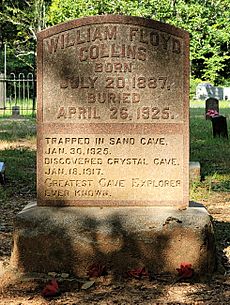
Floyd's body remained in the cave, and funeral services were held above ground. However, Homer Collins did not want Sand Cave to be his brother's final resting place. Two months later, Homer and some friends reopened the shaft. They dug a new tunnel and recovered Floyd Collins' remains on April 23, 1925.
His body was taken to Cave City for embalming. After a two-day viewing, on April 26, 1925, his body was buried on the Collins family farm. It was placed on the hillside above Great Crystal Cave. Lee Collins renamed this cave "Floyd Collins' Crystal Cave."
In 1927, Lee Collins sold the farm and cave to Dr. Harry Thomas. The new owner put Collins' body in a glass-topped coffin. He displayed it in Crystal Cave for many years. On March 18–19, 1929, the body was stolen. It was later found in a nearby field, but the injured left leg was missing. After this, the remains were kept in a chained casket in a hidden part of Crystal Cave.
In 1961, Mammoth Cave National Park bought Crystal Cave. The Collins family had always disliked Floyd's body being displayed. At their request, the National Park Service re-buried him in 1989. He was laid to rest at Mammoth Cave Baptist Church Cemetery in Mammoth Cave, Kentucky. It took 15 men three days to remove the casket and tombstone from the cave.
Floyd Collins' Legacy
Floyd Collins' life and death have inspired many creative works. These include a musical called Floyd Collins by Adam Guettel and Tina Landau. There is also a film documentary, several books, a museum, and many songs about him.
In 2006, actor Billy Bob Thornton bought the film rights to a book called Trapped! The Story of Floyd Collins. A screenplay was written. However, Thornton's rights expired, and another producer bought them in 2011.
Musicians like Fiddlin' John Carson and Vernon Dalhart recorded a song called "The Death of Floyd Collins" in 1925. John Prine and Mac Wiseman also recorded "Death of Floyd Collins" on their 2007 album Standard Songs for Average People.
See also
- Moose River Disaster, a mine cave-in widely covered on radio in 1936




